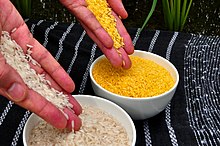Heterologous expression
Annealing cools down the reaction to allow hydrogen bonds to reform and promote primer binding to their complementary sequences on the single-stranded template of DNA.
More recently, this technique has been successful in animal cells that cannot tolerate high-level bombardment, where instead DNA gold particles are delivered at lower helium pressure.
E. coli, yeast (S. cerevisiae, P. pastoris), immortalized mammalian cells, and amphibian oocytes (i.e. unfertilized eggs) are commonly for studies that require heterologous expression.
Prokaryotic expression is widely used in recombinant DNA technology to form easily manipulated proteins by well-known genetic methods with a low costing medium.
Prokaryotic and eukaryotic systems, most commonly bacteria, yeast, insects, and mammalian cells, and occasionally amphibians, fungi, and protists are used for studies that require heterologous expression.
Bacteria, especially E. coli, yeast (S. cerevisiae, P. pastoris), insects, and amphibian (oocyte) cells have been used as effective hosts for expressing foreign proteins.
It is widely used in recombinant DNA technology to form easily manipulated proteins by well-known genetic methods with a low costing medium.
A popular system utilized is Escherichia coli because of its rapid growth rate (~20–30 minutes), capacity for continuous fermentation and relatively low cost.
LPS, found in gram negative bacteria, is known to cause many degenerative disorders in humans and animals and affects the production of proteins in E. coli.
To date, B. subtilis has been used to successfully study different biological mechanisms including metabolism, gene regulation, differentiation, and protein expression and generation of bioactive products.
Yeast is a single cell fungus that uses high expression levels, fast growth, and inexpensive maintenance, similar to prokaryotic systems.
[3] A common protist eukaryotic expression system is the slime mold, Dictyostelium discoideum, and is unique as it has a circular plasmid, packaged similarly to chromatin.
[16] As a simple eukaryotic haploid organism, it can grow in high concentrations without the expensive conditions of mammalian cell culture, and perform post-translational modifications.
The filamentous fungi specifically have been a host system of interest, and includes Penicillium (where penicillin was derived), Trichoderma reesei, and Aspergillus niger.
[17] Through this host, it remains exceedingly challenging to heterologously express a complex, heteromultimeric metalloprotein like NifEN with a full complement of subunits, metalloclusters, and functionality.
The NifEN variant engineered in this bacterial host can retain its cofactor efficacy at analogous cofactors-binding sites, which provide proof for heterologous expression and encourage future investigation of this metalloenzyme.
[15] Heterologous expression systems can be clinically incorporated to evaluate enzyme activity under highly reproducible conditions for in vitro drug development.
[19][13] This works to minimize patient risk by serving as an alternative to highly invasive procedures, or potential for the development adverse drug reactions.
M. tuberculosis requires high biosafety level facilities for drug screening and has a slow growth rate which makes the process expensive and time-consuming.
[24] The benefits of using heterologous expression here is that it produces large amounts of target receptors of drugs of interest, and is generally inexhaustible, reproducible, and inexpensive.
[26] Several limitations prevent heterologous expression to generate products at an economically feasible level that have been observed in bacteria, yeast, and plants.
[25] First, these methods are still extremely expensive compared to natural production, often take a longer time to generate, and require special conditions for host culture and induction of expression.
This is often due to the mismatch in regulatory and expression induction pathways and machinery, and reflected in the observed degradation of certain amino acid sequences, decreased specific activity, incorrect membrane transportation, and glycosylation effects.
Specifically, incorporating different promoters or optimized genetic sequences and using variants or strains of organisms that allow for these post-translational modifications is an approach of interest.
To address errors in translation, it is possible to overexpress tRNA to mitigate any shortages, however, base modifications are still heavily dependent on the host system.
This has called into question the relationship between vector dosage and cellular toxicity as scientists recognize that inappropriate activation of these responses can cause severe side effects not only to the disease-infected cells but other healthy parts of the body.
[32] Although CRISPR (Clustered Regularly Interspaced Short Palindromic Repeats), a technique that allows for genes to be edited with ease may present certain benefits, but it may also cause further risks to the human body.
Until advancements are made to fully equip scientists with the knowledge to understand all potential benefits and risks associated with CRISPR editing, concerns regarding the safety of its applications remain.
[32] The possibility that editing could bring about an incomplete or inaccurate genetic sequence has been reported in several experiments related to both animal and human cell line studies.
[32] Since it is almost impossible to predict a favorable outcome with certainty, this technique makes germline editing all the more difficult to promote as a definite cure for anyone suffering from terminal illnesses.
